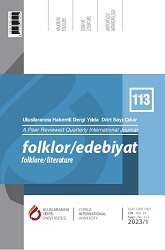Octavio Paz’ın “¿No Hay Salida?” Adlı Şiirinin Sembolizmi: Yıkıcı Zaman ve Mandala İmgeleri
The Symbolism in Octavio Paz’s Poem “¿No Hay Salida?”: Destructive Time and Mandala Imagery
Author(s): Mehmet İlgürelSubject(s): Poetry, Other Language Literature, Philosophy of Mind, Cognitive Psychology
Published by: Uluslararası Kıbrıs Üniversitesi
Keywords: Octavio Paz; the theory of the imaginary; destructive time; mandala;
Summary/Abstract: This work analyzes Octavio Paz’s poem “¿No hay salida?” (Is there no way out?) using the theory of imaginary, established by French thinker Gilbert Durand. In Durand’s conception of imaginary, diurnal and nocturnal orders of the image, which are largely characterized by opposing structures, processes and isotopic image constellations, have a decisive place. When the Mexican poet wrote the poem, he was in Japan on a diplomatic mission and going through a period of financial, family and psychological problems. Our analysis shows that Paz’s efforts to cope with his personal situation are reflected in his poetry through images. In this context, images that evoke destructive time, deterioration and death come to the fore, as well as the tendency to protect oneself from them through nocturnal order images that suggest isolation and privacy. I also utilized Carl Gustav Jung’s Analytical Psychology, as a source pertaining to the theory of imaginary, to interpret the image of the mandala. According to Jung, this symbol expresses the wholeness of the psyche and it serves in a defensive way for those who are affected by fragmentation. In parallel with this approach, mandala appears in the poem as an image that reflects the integrative function of unconscious origin.
Journal: Folklor/Edebiyat
- Issue Year: 29/2023
- Issue No: 113
- Page Range: 95-118
- Page Count: 24
- Language: Turkish

